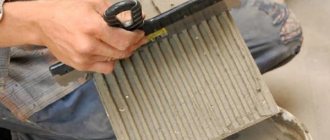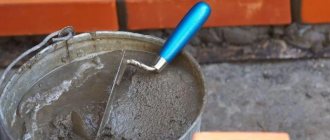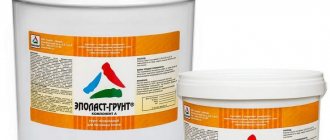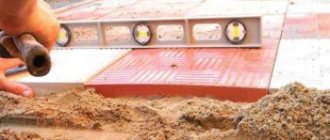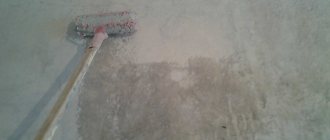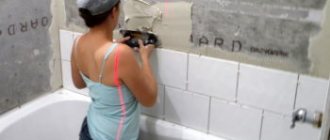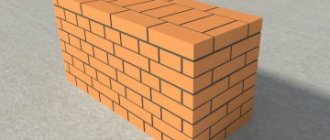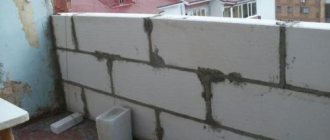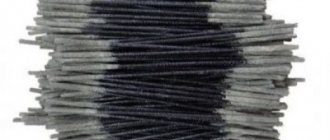Houses built from aerated concrete are characterized by reliability and durability. The strength and other operational parameters of the building largely depend not only on the quality of the blocks, but also on what kind of glue and in what quantity was used for the masonry. The choice of mixtures for joining aerated concrete products today is huge, but a good product is not cheap.
Agree, it is better to know in advance how much glue will be needed for the construction of an aerated concrete building. Then you will not have problems due to the fact that you purchased more or less mixture than you need. Determining the glue consumption for aerated concrete blocks per 1m3 is actually not difficult. You need to know some features and nuances.
In this article we will tell you why it is so important to be able to calculate the optimal amount of glue; we will provide a formula by which you can easily understand how many bags of the mixture you need. We will also list and consider the factors on which the amount of adhesive consumption depends. We will give advice on choosing and preparing glue for laying gas blocks.
Why do you need to know glue consumption?
In construction, houses made of aerated concrete are more economical than brick buildings. This is due not only to the cheapness of the blocks, but also to the fact that special glue is used as a connecting element.
It costs 1.5-2 times more than cement-concrete mortar, which is used for bricklaying. But at the same time, its consumption is six times lower. The result is good savings. But, unfortunately, not everyone knows how to determine how much adhesive composition will be used for masonry. This leads to a number of problems.
Adhesive for laying aerated concrete blocks does not shrink significantly, and also eliminates the appearance of places with increased heat conductivity, providing a stronger and more durable connection
The advantages of having the knowledge and skills to accurately calculate the required amount of glue for building a house from aerated blocks are obvious.
Firstly, this is an opportunity to save money. If you correctly determine the amount of consumption, then there should be no extra bags of glue left after the completion of construction work. Accordingly, there will be no overpayment.
Secondly, situations where the glue has run out and you need to buy more are excluded. The store where you previously purchased the mixture may not have the brand you need. Then you will have to either choose glue from another company, which is not welcomed by experts, or look for the required product elsewhere, or wait for delivery of the required brand. In the latter case, construction will have to be suspended for some time. If you calculate the glue correctly in advance, then such hassle can be avoided.
Thirdly, you will be able to check the estimate compiled by specialists. Some construction companies are unscrupulous and deliberately inflate costs.
Fourthly, knowing the specifics of the calculation, it will be possible to dilute the amount of dry adhesive that is currently needed to lay a certain number of aerated concrete blocks.
Glue for gas blocks is prepared by combining dry matter with water. The mixture is not stored for a long time: it should be used within 2.5-3 hours
If during the construction of a building made of aerated concrete, significantly more or less glue was used than the planned volume, this indicates that either the calculation of the mixture was carried out incorrectly, or significant errors were made during the construction of the structure, for example, the wrong installation technology was used.
Types of adhesive material
The adhesive solution used for aerated concrete contains dry cement of the highest category, as well as polymer and mineral additives. Each manufacturer jealously guards its secrets, so the range of products is very different both in terms of quality characteristics and pricing policy.
You can find out which tile adhesive is better in the kitchen, as well as in other rooms, from this article.
Which adhesive is best for aerated concrete?
There are two main types of glue:
- A universal composition for carrying out work at any time of the year. Includes special frost-resistant chemicals that lower the freezing point of water and help maintain all quality characteristics at air temperatures down to – 10º C.
- “Summer” glue is used exclusively at above-zero air temperatures; the strength of the connection is not guaranteed if the temperature conditions are not observed.
The main difference between “winter” glue will be its relatively lower consumption. Also, the prepared solution must be used within half an hour, while ordinary glue is viable for up to two hours in its finished form.
You can find out which adhesive for bathroom tiles is best to use in this article.
The dry mixture also differs in appearance: frost-resistant glue is a fine gray powder, while regular glue is white.
Payment procedure
Aerated concrete blocks have precise geometry. Due to this, they can be laid on a thin layer of the binder mixture. When determining glue consumption, you need to adhere to a special algorithm.
Calculation procedure:
- Calculate how many aerated concrete blocks are needed to construct a building.
- Assess the evenness of the surface of the products and prepare them for laying.
- Decide on the thickness of the seam.
- Read the instructions for the glue. Pay attention to dilution and consumption. Similar information is provided on the back of the bag.
- Calculate the required amount of adhesive dry substance.
The standard consumption of aerated concrete adhesive per 1 m3 varies from 15 to 30 kg of dry mass. With a layer thickness of 1 mm, about 25 kg of mixture per cubic meter is required. This is one bag of composition.
Similar proportions are typical for blocks with a flat surface, without visible deformations. It is recommended to take one bag of glue in reserve. For example, if 20 cubic meters of aerated concrete blocks were purchased, then 21 bags of adhesive will be required to lay them.
The seams between aerated concrete blocks are made from 1 mm. An adhesive layer of 2-3 mm is considered optimal. For comparison, the thickness of the cement-concrete mortar for reliable fixation of bricks according to the standards must be at least 10 mm
It is not always possible to purchase a batch of ideal blocks. Therefore, in practice, glue consumption can be 1.5 bags per 1 m3. All these figures are approximate and depend on various factors.
To accurately calculate glue consumption, you should use the following formula: ((L+H)/(L×H))×d×1.4
P is the glue consumption in kilograms per cubic meter;
L, H – length and height of the aerated concrete block, respectively (in meters);
d – seam thickness;
1.4 – the consumption value of the dry adhesive mixture, provided that the layer thickness is 1 mm.
Today there are many specialized resources where you can determine glue consumption using an online calculator. This tool takes into account various factors that can affect the volume of block bonding compound.
But for maximum accuracy, it is better to perform all calculations manually. In this case, it is necessary to take into account the dimensions of door and window openings, and the gables of the building. It is important to be as careful as possible when filling out the form. When carrying out calculations, you need to carefully operate with units of measurement, otherwise there is a risk of seriously making mistakes in the calculations.
Characteristics of adhesive for aerated concrete
Also, when choosing adhesive for aerated concrete blocks, take into account the technical characteristics of the latter and the type of construction itself. In particular, we are talking about the following parameters:
- filler fraction (the smaller it is, the smaller the seam will be);
- temperature (construction season is taken into account);
- amount of water (the smaller it is, the less moisture will be added to the blocks);
- thickness of the required layers;
- drying and holding time (important in case of correction of defects and installation flaws).
Attention! To avoid cold bridges when working with aerated concrete, it is necessary to use fine-grained glue. It provides a more uniform and thin masonry.
In order for the glue consumption to be close to optimal values, and the structure to be strong enough, you need to make even thin layers of the adhesive mixture. An important point is also the quality of the solution, which is prepared using a drill with a special attachment or a construction mixer. The water should be at room temperature. Naturally, you should not ignore the instructions included with the glue.
Features of calculating glue consumption
The amount of glue required to hold aerated concrete blocks together is calculated in kilograms per square or cubic meter.
When purchasing bags of glue for laying aerated concrete blocks, it is important to pay attention to the shelf life of the product. If the composition is expired, then its bonding properties will be worse
To achieve the desired result and obtain a high-quality, reliable seam, you need to observe all proportions when diluting dry matter and follow the recommendations of specialists. You should not try to save money by adding more water to the adhesive mixture than indicated in the instructions. This reduces adhesion.
It is also not recommended to make the seam thinner than necessary to minimize consumption - this will worsen the quality of bonding of the blocks.
When determining the amount of glue consumption, you need to take into account some features. The consumption declared by the manufacturer may be lower or higher than the actual one. This is explained by the influence of a number of additional factors on the result.
What determines glue consumption?
With large volumes of work, it is quite difficult to determine how much glue is needed for laying aerated concrete blocks. It happens that not 25 kg of glue is used per cubic meter, as planned, but 30-40 kg or 14-15 kg.
To obtain consumption data that is as close to real as possible, it is worth taking into account the influence of a number of factors.
You should not use used blocks. Their price is much lower than new products. But they have significant defects. To make smooth masonry and build a strong house, you will need a lot of glue
The amount of adhesive required for laying aerated concrete blocks depends on the quality of the product. The cheaper the mixture, the worse its composition. It may contain too much sand and other unnecessary fillers.
This negatively affects the bonding properties. Accordingly, the consumption of such glue will be high. If the bulk is represented by a binder, then the mixture will be used more economically.
The geometry of the blocks also has a great influence. The smoother the surface of aerated concrete products, the thinner the layer of masonry adhesive can be made. This will allow you to achieve maximum savings. The presence of defects, on the contrary, requires the use of more adhesive to eliminate them.
The masonry technique and the level of skill of the builder play a certain role. Inexperienced workers often make mistakes and use too much compound to correct them. This does not improve the quality of the result, but the glue consumption increases.
The consumption of the mixture largely depends on the thickness of the seam the craftsman will make. The higher this indicator, the more glue will be spent on building a house.
Another factor is the presence of a reinforcing layer. Often, when creating aerated concrete walls for two-story and taller houses, builders use reinforcement. Then a thicker layer of glue has to be applied to the blocks. This increases material consumption.
It is not worth building an aerated concrete house in the rain. Water will get onto the blocks and into the glue container. This will reduce the quality of construction
Also, the consumption of the composition largely depends on the temperature and weather conditions. The hotter it is outside or in the room where the wall is being built, the more glue will be consumed. This is explained by the fact that the evaporation of the mixture increases.
Approximate glue consumption in different cases
It is important to take into account all the nuances when calculating the amount of glue consumption for laying aerated concrete blocks. This will allow you to determine as accurately as possible how many kilograms of dry mixture will need to be purchased to build a house.
The table below shows the glue consumption depending on the thickness of the seam and the brand of the composition.
| Brand of adhesive mixture | Seam thickness, mm | Consumption of adhesive mixture in kg per 1 m3 |
| AEROC | 1 | 20 |
| Ceresit ST 21 | 2 | 52 |
| Ytong | 2 | 60 |
| UDK | 1 | 25 |
| Kreisel 125 | 2 | 50 |
| Baumit PorenbetonKleber | 2 | 60 |
The approximate consumption of glue depending on the thickness and density of aerated concrete blocks is given in the following table.
| Block thickness in cm | Density of aerated concrete blocks in kg/cub.m | Glue consumption in kg per cubic meter |
| 10 | 300-400 | 19,3-19,4 |
| 15 | 300-400 | 19,9-21,0 |
| 20 | 300-400 | 16,4-16,8 |
| 25 | 300-400 | 15,9-16,2 |
| 30 | 300-400 | 15,5-15,8 |
| 37,5 | 300-400 | 15,1-15,4 |
| 40 | 300-400 | 14,9-15,1 |
These consumption indicators are relevant for cases where the thickness of the adhesive layer does not exceed 1-2 mm, and the blocks do not have significant defects in terms of geometry.
Glue composition and weather conditions
When choosing adhesive for aerated concrete, consider the time of year and local weather conditions. In winter, it is better to use a frost-resistant type of glue with special additives. This mixture is mixed with hot water (40-60°) and kept in a warm room, and to take it outside you will need an insulated container with a lid. In winter conditions, installation must be done quickly; only 2-3 minutes of time will be available for correction.
Attention! The use of winter glue for aerated concrete blocks requires strict control over the quality of filling the seams and their optimal thickness.
As for the composition of the adhesive, for aerated concrete it should include:
- Portland cement, which directly affects the strength of the connection;
- fine sand;
- polymer additives that increase adhesive properties and the degree of plasticity;
- additives-modifiers for the prevention of cracks in seams under the influence of temperature.
Secrets of economical spending
If you follow some expert advice, the use of adhesive when laying aerated concrete will be more economical.
Experienced master builders know how to work with aerated concrete and glue. Therefore, they build a house faster and more economically in terms of material consumption. When constructing a building from aerated blocks on your own, you need to be careful and think through everything carefully, do not rush
The use of special tools speeds up the construction process and minimizes the use of glue, and, accordingly, reduces the cost of work. It is recommended to use a ladle, a rubber hammer, a square, a grater with sandpaper, and a saw for masonry.
The glue should be applied with a spatula or a special spatula. Then the composition will apply more evenly and it will be possible to minimize its consumption. Before laying, the blocks must be cleaned of dirt. It is important to dry them well so that they are not wet.
How to make adhesive for aerated concrete with your own hands
The working solution can be used for laying slabs, cellular concrete blocks, for filling and leveling surfaces. The composition is applied to a clean base.
The preparation of the mixture follows the following principles:
- dry matter is poured into water, 0.21-0.24 l is taken per 1.00 kg;
- the mass is stirred manually or with a tool - a drill at low speeds;
- the result should be a homogeneous dough;
- The product is ready for application after 3-5 minutes. maturation;
- re-stirring before use;
- experienced craftsmen advise using the material within 30 minutes, although manufacturers indicate an hour-long viability of the glue.
The glue is evenly distributed onto the horizontal and vertical surfaces of adjacent blocks using a toothed grater or other tool, and the next block is laid.
Tips for choosing adhesive mixtures
The range of adhesives for aerated concrete masonry on the market is quite extensive. All compositions are divided into gray and white. The first ones are considered universal. They can be used at any time of the year. They contain additives that increase frost resistance. This glue has certain temperature limits for use.
White compounds are suitable for work in the warm season. They contain Portland cement. This substance gives the mixture a light tint. White glue should be used for laying blocks indoors. The seam is aesthetically pleasing and does not require additional processing.
Typically, a gray type of glue is used to build aerated concrete houses. This is explained by the fact that this composition is universal and is more often found on sale.
Adhesives for aerated blocks from the following companies are very popular: Ceresit, Kreisel, UDK, Ytong, Real. Products from new companies appear on sale regularly. Therefore, not all builders can comment on the quality of a particular brand of glue. A little-known mixture for laying gas blocks can be no worse in quality than branded products.
Due to the wide range of adhesive compositions for aerated concrete blocks, many have problems with choice. The question of which glue is best for building a house is quite relevant. There are different ways to figure out which mixture to use.
Experts advise paying attention to the composition. It should contain a lot of binders and a minimum concentration of additional inclusions, which are used to reduce the cost of products. The choice is made through testing and comparison.
Builders recommend purchasing 2-3 types of glue in quantities of up to 1 kg and testing their quality in practice. The solution should be prepared according to the manufacturer's instructions. Next, glue two blocks together with each mixture. Leave to harden for a day. A day later, try to break the structure in the seam area.
You should purchase glue for laying gas blocks from reliable companies. It is better to choose well-known and proven brands. This guarantees high quality mixture
The result will show how good the glue was used. If the fracture site coincides with the seam, then it is better not to use this mixture. If only the aerated concrete block was damaged, this indicates the high quality of the glue. This composition can be safely used for any type of work.
If the fault partially touches the seam, this means that the adhesive mixture will not provide sufficient strength to the structure, so it is better not to use it, especially when constructing multi-story buildings.
Another way to determine the quality and choice of glue is to check its weight after hardening. It is necessary to buy several types of adhesive compositions for testing and pour them in equal quantities into containers of the same size.
Wait a day and evaluate the result. To do this, you need to weigh each of the containers. Preference should be given to the glue whose weight decreased the most after hardening. This indicates that a lot of moisture has been removed and the composition has become more durable.
If you bought glue of an unknown brand, then it is better not to start building a house using it until the quality is checked. It will be more difficult to correct the situation later
Testing glue using the above methods is troublesome, costly in time, effort and money. But such a check will help to accurately assess the quality of the composition. After all, manufacturers' promises do not always correspond to reality.
It makes sense to carry out testing when planning large-scale construction. This will help not only check the quality of the glue, but also more accurately calculate its consumption.
Advantages of using adhesive for aerated blocks and its properties
As we understand, the special adhesive composition for gas blocks was developed for a reason. Its use has some advantages over, say, the usual and familiar cement mixture that is used when working with bricks. Now we will actually list them:
- the presence of Portland cement in the adhesive composition, as well as fractional sand. This allows you to reduce the thickness of the applied layer;
- Thanks to its structure, the glue is evenly applied to the work surface, filling the space. Due to this, the adhesive properties increase;
- One bag of dry mixture (25 kg) will take about 5.5 liters of water. Due to this, the humidity inside the building will not be increased;
- low ability to transmit heat. Thanks to this property, the likelihood of cold spots forming is reduced;
- high ability for adhesion (adhesion to the working surface);
- resistance to cold and humidity;
- quick setting and drying of the adhesive composition without (!) any shrinkage;
- economy. The fact is that glue can be used not only for its intended purpose - that is, for gluing, but also as putty;
- relatively low cost;
- ease of use (of course, if you have certain skills).
It is worth noting that the type of glue that should be used during work depends on weather conditions. For example, in the cold season it is necessary to choose a special frost-resistant glue. It should, of course, be kneaded at room temperature using hot water (40–60°C). You need to take the finished mixture out into the cold under a lid. At the same time, keep in mind that the glue hardening time in the cold is quite short, so it is necessary to correct the element placed on the glue immediately. You will have no more than three minutes to do this.
Among the components of the adhesive composition the following must be present:
- Portland cement;
- fine-grained sand that has undergone sieving;
- modifiers;
- polymer additives.
To reduce the consumption of fastening composition per cube, you should use the right tools when working. Here is a list of everything you will need for work:
- notched spatula for applying adhesive composition;
- rubber hammer;
- mixing blade;
- saw with carbide teeth;
- wall chaser;
- coarse grater;
- metal brush;
- 90°C square to cut at right angles.
Why theory and practice do not coincide
The answer to the question: why the theoretical consumption per m3 of aerated concrete adhesive does not coincide with practical data is of interest to many. There can be many reasons, and one of them is the quality of the mixture. It’s not only about the reliability of the manufacturer and strict adherence to technological processes in the manufacture of the dry composition, it is also important: whether storage standards are met, whether external conditions have affected the quality (you can verify this by checking the integrity of the packaging) and whether the expiration date of the material has expired.
It will also affect material consumption:
- the quality of the aerated block (it must have a perfectly flat surface, without chips or defects, then consumption will be minimal);
- clarity of geometric shape;
- qualifications of the craftsman (a specialist with experience will be able to make a minimal seam, ensuring high-quality masonry);
- tools used to perform work;
- weather.
Attention! In order to minimize the consumption of adhesive for aerated blocks, it is necessary to periodically stir the solution during operation. This will maintain its uniformity and prevent premature setting (drying).
Consumption per 1 m 3
Average glue consumption for aerated concrete blocks can vary depending on the thickness of the applied layer and the quality parameters of the surfaces being bonded:
- one bottle of adhesive foam can replace a bag of dry adhesive mixture weighing 25 kg. The consumption per cubic meter of aerated concrete masonry most often does not exceed one balloon tube
; - dry adhesive mixtures for aerated concrete blocks are sold in bulk form, packaged in standard bags, so for each cubic meter of block masonry approximately 20-25 kg of high-quality adhesive materials are consumed
.
The excellent geometric accuracy of aerated concrete building blocks makes it possible to minimize glue consumption. The optimal thickness of the adhesive joint should vary between 1-3 mm
.
When purchasing building blocks, managers will calculate the required number of bags of adhesive based on the consumption of adhesive for gas silicate blocks per 1m3, and will offer to buy it together with the blocks to save on delivery. But don’t rush to take the whole batch of glue at once
. If you have your own vehicle, it won’t be too difficult to bring a few bags from the nearest store.
Firstly, there are often cases when the developer, after finishing laying the walls, has several extra bags left
glue.
Secondly, oddly enough, adhesive for cellular concrete at the factory can cost more
than in hardware stores. Find out prices in advance.
Thirdly, you can buy 1-2 bags of glue from different manufacturers for testing and invite builders to choose which one is more convenient to work
and fasten the blocks.
Aerated concrete: features and main advantages
When talking about aerated concrete, we mean a modern building material made in the form of blocks of porous concrete (often called “aerated concrete blocks”). The material is light in weight, can be easily processed with conventional repair tools (drilled, cut, sawn), and nails can be easily driven into such walls. In the process of producing aerated concrete, the following are used: cement, sand, special gas-forming agents (aluminum pastes, suspensions) and additives (lime, gypsum). Thanks to its unique structure and composition, aerated concrete has a number of undeniable advantages, which is why it is increasingly being chosen for the construction of bathroom walls. Material:
- retains heat well;
- environmentally friendly (does not emit toxic substances even when exposed to high temperature and moisture);
- has good vapor permeability (due to which moisture and steam are quickly removed from the room);
- not subject to rotting;
- fire resistant;
- designed for a long service life (75-100 years).
As you can see, aerated concrete is perfect for constructing bathroom walls; in addition, it is convenient to calculate the amount of material and lay a neat partition. But many are faced with one problem: they buy aerated concrete blocks and glue for laying them according to a standard calculation of consumption, but in fact there is not enough of it, which leads to a temporary stop of work.
